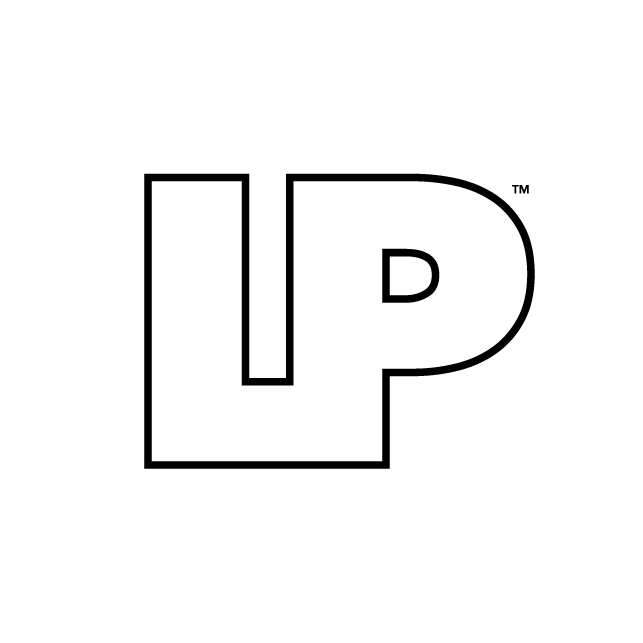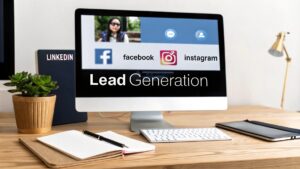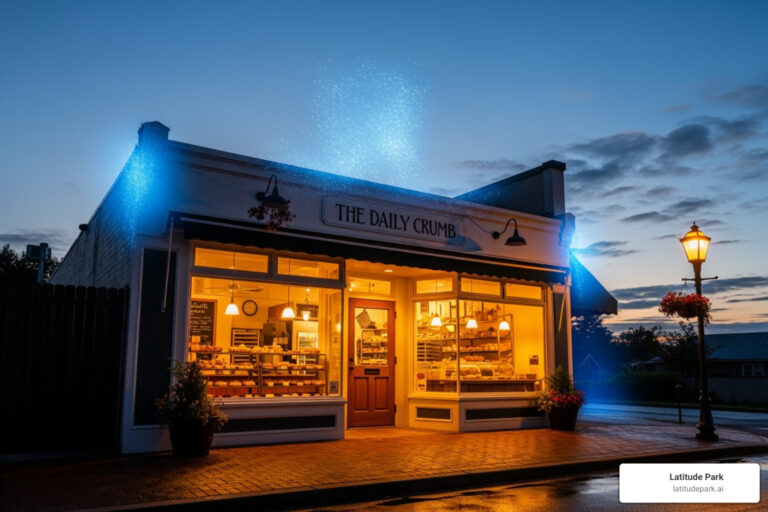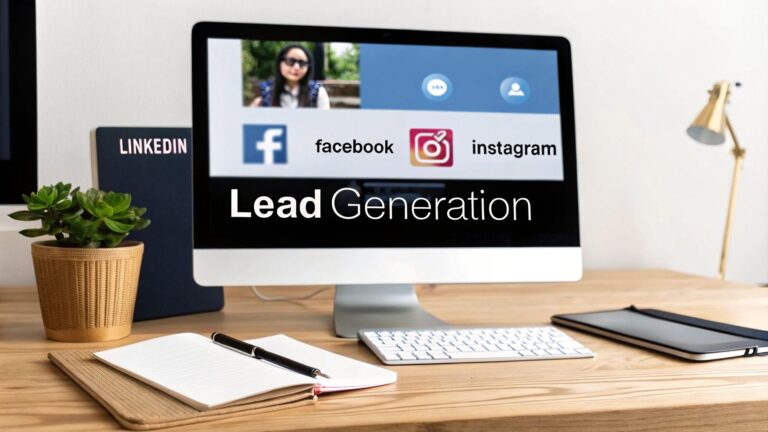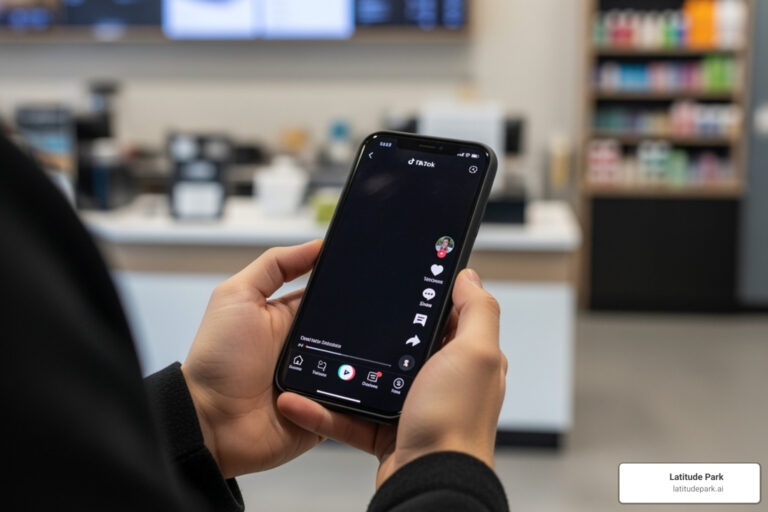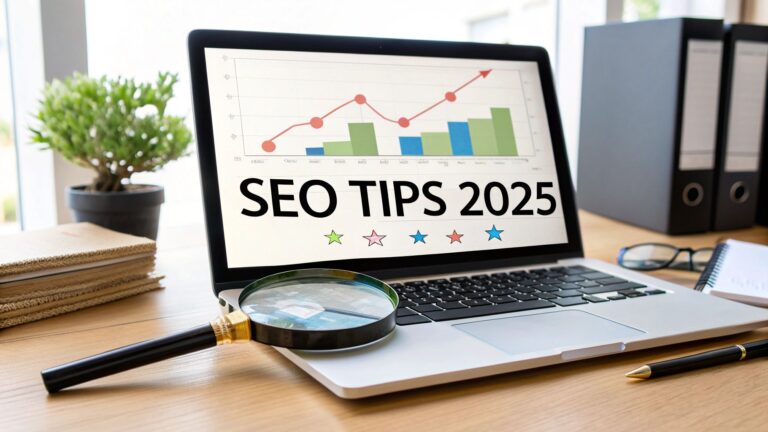Not too long ago, social media was just a digital billboard—a place to shout your brand's name from the rooftops and hope someone noticed. Those days are over. Today, it’s a powerhouse for growth, connecting you directly with potential customers right where they spend their time.
Social media lead generation is all about turning passive followers into active business prospects. It’s the art of creating content and running campaigns that get people interested enough to hand over their contact information. For example, instead of just posting a picture of a new product, a smart brand might post a video tutorial and offer a downloadable "how-to" guide in exchange for an email.
Why Social Media Is a Lead Generation Powerhouse
Instead of waiting for customers to stumble upon your website, you can slide right into their feeds. This direct line of communication lets you offer solutions the moment someone realizes they have a problem.
Think about it: the modern buyer’s journey often starts and ends on a social platform. A potential customer might see a Facebook ad for a new pair of running shoes, click to the brand's Instagram profile to see user photos, read the comments for reviews, and then click the link in bio to buy—all without ever performing a Google search. This creates a massive opportunity for businesses that know how to play the game.
From Awareness to Action
The real magic happens when you move beyond simple brand awareness and start driving action. With the sophisticated targeting tools available on platforms like Facebook and LinkedIn, you can reach your ideal customer with surgical precision, often at a fraction of the cost of old-school marketing.
For a deep dive into how one of the biggest platforms works, this guide on mastering lead generation on Facebook is a great place to start.
This isn't just theory; the data backs it up. Take a look at where the leads are actually coming from.

As you can see, Facebook and LinkedIn are the heavy hitters, making them essential channels for almost any business looking to generate leads.
Choosing the Right Platform for Your Leads
Not all social platforms are created equal, especially when it comes to lead generation. Where you focus your energy depends entirely on who you're trying to reach and what you're selling. A B2B software company will find its home on LinkedIn, while a visually-driven D2C brand will thrive on Instagram. Here's a quick breakdown to help you choose your battleground.
| Platform | Best For | Primary Audience | Key Lead Gen Tactic |
|---|---|---|---|
| B2C, Local Businesses, D2C Brands | Broad; All Demographics | Lead Ads, Targeted Content Offers, Community Building | |
| B2B, Professional Services, High-Ticket Sales | Professionals, Decision-Makers | Content Syndication, InMail, Lead Gen Forms, Networking | |
| E-commerce, Visual Brands (Fashion, Food, Travel) | Gen Z & Millennials (18-34) | Shoppable Posts, Link in Bio, Story Ads with CTAs | |
| X (Twitter) | Tech, News, B2B Thought Leadership | Tech-savvy, News Junkies | Lead Generation Cards, Direct Engagement, Polls |
| E-commerce, Home Decor, DIY, Creative Brands | Primarily Female; Planners | Promoted Pins, Rich Pins, Visual Search |
This table isn't exhaustive, but it's a solid starting point. For instance, a local real estate agent might use Facebook to run lead ads targeted to people in specific zip codes showing interest in "mortgage calculators," while a management consultant would use LinkedIn to share an industry report with C-suite executives. The key is to avoid spreading yourself too thin. Pick one or two platforms where your ideal customers are most active and go deep.
The Efficiency of Social Platforms
Social media has become a core part of lead generation for businesses worldwide. By 2025, an estimated 66% of marketers will be using social platforms specifically for this purpose. What's even more impressive is that many achieve these results by spending just six hours a week on social media activities. That's a massive return on a relatively small time investment.
The real power of social media lead generation lies in its ability to blend into the user's native experience. A well-placed lead form or a compelling content offer feels less like an ad and more like a helpful resource.
This efficiency is a total game-changer, especially for small businesses or franchises that don't have massive marketing teams or nine-figure budgets. You can drive significant results by understanding which platform works best for your business and focusing your energy there.
Of course, none of this works without a solid plan. Building an effective strategy is the first step, and you can learn more about why your business needs a social media marketing strategy in our detailed guide.
Creating Lead Magnets People Actually Want

On social media, a person’s email address is pure gold. You can't just ask for it; you have to earn it. People are bombarded with offers all day long, so you need to present something genuinely compelling in return. This is where a killer lead magnet makes all the difference.
It's time to forget about those generic, low-effort PDFs that end up collecting digital dust. A truly effective lead magnet zeroes in on a specific, urgent problem your audience is facing and delivers an immediate solution. It’s less of a transaction and more of a genuine value exchange.
Solve a Specific Problem
The secret to a lead magnet that converts like crazy is specificity. A B2B tech company will get crickets with a broad "Guide to Marketing." But an "Exclusive ROI Calculator Template for SaaS"? Now you’re talking. That speaks directly to a real need and offers a tangible tool, not just vague information.
This works in any industry. A fitness brand could offer a "5-Day Core Strength Video Challenge" instead of another generic "Workout Plan." The challenge is exciting—it has a clear outcome, a defined timeline, and an interactive feel that’s far more enticing to someone scrolling through their Instagram feed. The practical insight here is that users on social media crave immediate gratification and tangible outcomes.
These kinds of offers work because they promise a quick win. They hit on a pain point someone is feeling right now and offer a clear path to relief.
Crafting the Perfect Offer
To build an offer that truly resonates, you need to get inside your audience's head. What keeps them up at night? What simple tool or template would make their job 10x easier? Your lead magnet should be the answer to one of those burning questions.
Here are a few ideas that go way beyond the basic ebook:
- Interactive Quizzes: A financial advisor could create a "What's Your Retirement Readiness Score?" quiz. It's fun, it's personal, and it delivers instant, customized results.
- Checklists or Worksheets: A marketing agency could offer a "25-Point Social Media Profile Audit Checklist." This is super actionable, easy to digest, and helps potential clients self-diagnose their own needs (and realize they need your help).
- Webinar Recordings: Offer on-demand access to a high-value webinar. This positions you as an expert and captures leads from people who couldn't make the live event.
- Resource Libraries or Toolkits: Bundle your best stuff—templates, swipe files, and guides—into one high-value package. A practical example: a design agency could offer a "Brand Launch Toolkit" with logo templates, color palette suggestions, and a content calendar.
The best lead magnets feel like something you could have charged money for. When you're generous, you build trust and make potential customers eager to hear what else you have to say.
The goal is to create something so undeniably useful that your audience feels like they’d be foolish not to download it.
Designing a High-Converting Landing Page
Once you've got a fantastic lead magnet, you need a landing page that sells it. Your copy needs to speak directly to your audience's pain points. Start your headline with a hook that grabs their attention by highlighting the problem your lead magnet solves.
Use clear, benefit-driven bullet points to explain what’s inside. Don't just say, "Includes three templates." Instead, say, "Save hours of work every week with three copy-and-paste templates." See the difference? The latter focuses on the outcome, which is what the user truly wants.
Finally, make your call-to-action (CTA) impossible to ignore. Use strong, action-oriented language like "Get My Free Calculator" or "Start the Challenge Now." The opt-in process has to be dead simple, especially on mobile, if you want to turn those casual social media visitors into genuinely interested leads.
Winning Leads Organically Without Ad Spend

While paid ads give you a fast track to scaling, you don't always need a hefty budget to build a powerful social media lead generation machine. Organic strategies are your foundation—the long game.
They create a system that consistently draws in high-quality prospects by building real trust and a genuine community. It's about turning your social profiles from simple digital billboards into dynamic, conversion-focused hubs.
The trick is to see every single part of your social presence as an opportunity. This means you have to move beyond just posting content and start actively engineering your profiles to guide visitors toward becoming leads. When you deliver consistent value, you attract followers who aren't just fans, but potential customers ready to take the next step.
Optimize Your Profiles For Conversion
Your social media bio and profile sections are prime real estate. Way too many businesses treat them as an afterthought, but they're often the first place a potential lead looks when they want to know more. Every element should be fine-tuned to encourage action.
On LinkedIn, for instance, the "Featured" section is incredibly powerful. Instead of letting it sit empty, use it to pin a high-value case study that shows off clear results. You could also feature a link that goes directly to a free consultation booking page or a downloadable industry report. Just like that, your personal or company profile becomes an always-on lead capture tool.
The same idea applies everywhere else:
- Twitter/X: Pin a tweet to the top of your profile that links to your latest webinar sign-up or a free resource. Keep it fresh.
- Instagram: Use that single link in your bio strategically. Tools like Linktree or Later's Link in Bio let you create a mini-landing page with multiple CTAs, sending traffic to your blog, lead magnets, and service pages.
- Facebook Page: Double-check that your "Call to Action" button is set up correctly. Whether it's "Sign Up," "Learn More," or "Contact Us," that button needs to point directly to your most important lead generation offer.
Create Content That Inspires Action
Your content’s job isn't just to get likes; it's to start a conversation that ends in a conversion. The best organic content for lead gen solves a problem, educates your audience, or offers a unique perspective that naturally prompts a follow-up.
A classic example is a post that breaks down a complex topic, followed by a CTA like, "Want the full checklist? Drop a 'checklist' in the comments, and I'll send it to you."
This "comment-to-DM" strategy is a winner. It juices your post's engagement in the algorithm while letting you start a personal dialogue with an interested prospect in their direct messages. That's where you can privately share the link to your lead magnet. For instance, a mortgage broker could post a carousel explaining the "5 Biggest First-Time Homebuyer Mistakes" and use this strategy to deliver a detailed guide.
The goal of organic content is to make the "ask" feel like a natural next step. If you've just provided immense value in a post, offering a deeper resource in exchange for an email doesn't feel like a sales pitch—it feels like a helpful extension of the conversation.
Engaging directly with niche communities is another potent tactic. By participating in relevant Facebook Groups or LinkedIn industry forums, you can establish yourself as an authority. Answer questions thoughtfully and share your expertise without being overly promotional. This builds credibility and makes people want to learn more about you.
For more ideas on how to connect your online efforts to real business results, explore these small business digital marketing tips to drive leads and sales. By consistently showing up and providing value, you build a brand that people trust—and people buy from brands they trust.
Scaling Your Efforts with Paid Social Ads

Organic growth is fantastic for building a solid foundation. But once you’ve figured out what resonates with your audience, paid advertising is the rocket fuel you need to really scale your social media lead generation.
Think of paid ads as your express lane. You get to move beyond your existing followers and put your very best offers directly in front of a hand-picked, highly targeted audience. The result? Predictable, measurable growth. This isn't about randomly "boosting" posts; it's a strategic play to fill your pipeline.
Supercharge Conversions with Native Lead Forms
One of the biggest conversion killers in lead generation is friction. Every extra click, every form field, every second a user has to wait for a page to load—it all causes people to drop off. This is exactly where native lead generation ad formats become your secret weapon.
Platforms like Facebook and LinkedIn have built ad types specifically to solve this problem:
- Facebook Lead Ads: When a user clicks on one of these ads, a form opens right inside the Facebook app. The best part? It often pre-populates their name and email from their profile. All they have to do is tap a couple of buttons, and they're in.
- LinkedIn Lead Gen Forms: These are the B2B equivalent and they work beautifully. You can attach a lead form to your Sponsored Content or Message Ads, making it ridiculously easy for a busy professional to grab your latest whitepaper without ever leaving the LinkedIn platform.
By cutting out the extra steps, you make the sign-up process painless. In practice, this simple change can often cut your Cost Per Lead in half compared to sending traffic to an external landing page.
Precision Targeting for High-Quality Leads
Here’s where paid social ads truly shine: the targeting. You can get incredibly granular about who sees your ads, which means you stop wasting your budget on people who will never become customers.
A great place to start is with people who already know you. Custom Audiences are your best friend for this. You can build these audiences from lists you already have—like existing customers or email subscribers—or from people who have visited specific pages on your website. A practical example is creating a custom audience of everyone who visited your pricing page in the last 30 days but didn't convert, then showing them an ad with a special case study.
Once you have a Custom Audience that's performing well, you can take it a step further by creating a Lookalike Audience. The platform’s algorithm will analyze the common traits of your source audience and then go find a whole new group of users with similar characteristics. It’s a brilliant way to find fresh, high-quality prospects who look just like your best customers.
Don't get caught up in chasing lead volume. The real goal is to get high-quality leads who have a genuine chance of becoming paying customers. Precision targeting is how you make that happen.
Budgeting and Measuring for ROI
Running paid campaigns without a smart approach to budgeting and measurement is like flying blind. The financial side of social media lead generation is no joke. On average, companies generate around 1,877 leads per month from social, with the average cost per lead hovering around $198.44. Those numbers make it pretty clear why targeting and smart nurturing are so important. You can dig into more lead generation stats to see just how critical it is to get this right.
Forget about vanity metrics like impressions or clicks. You need to track the numbers that actually hit your bottom line. The only two metrics that truly matter are:
- Cost Per Lead (CPL): Simple and direct. How much are you paying for every single lead you generate?
- Lead-to-Customer Conversion Rate: This is the big one. What percentage of those leads are actually turning into paying customers?
By keeping a close eye on these two KPIs, you can make data-backed decisions. You’ll know exactly which campaigns to scale up, which ones to tweak, and which ones to turn off, ensuring every dollar you spend is delivering a profitable return.
Turning Clicks into Customers with Social Commerce and Influencers
The wall between social media and e-commerce is crumbling, and smart marketers are taking advantage. It’s no longer just about pushing people off-platform to your website. Now, you can capture leads right inside the apps where your audience is already spending their time.
This shift turns casual scrolling into a direct line to your sales funnel.
Two of the biggest drivers behind this are social commerce and influencer marketing. The real magic happens when you stop treating them as separate tactics and start blending them together. This creates a smooth experience where a trusted recommendation flows directly into a sign-up or an exclusive offer.
Turn Social Shoppers into Warm Leads
Features like Instagram Shops and Facebook Shops are more than just digital storefronts—they're powerful lead-capture machines in disguise. You have to think beyond the immediate sale. What else of value can you "sell" in your shop?
A fashion brand, for example, could list an upcoming collection in their shop. But instead of a "Buy Now" button, they use a "Notify Me" button that links to a landing page. Users sign up for early access, and just like that, you've turned a window shopper into a high-intent lead. You caught them right at their peak moment of interest.
This isn't just for retail, either. The same playbook works for almost any business:
- Service-Based Businesses: A consultant could list a "Free 30-Minute Strategy Session" as a product, collecting lead info during the "checkout" process.
- SaaS Companies: You could offer an "Exclusive Beta Access" sign-up for a new feature, framing it just like a hot pre-order item in your shop.
The trick is to see your social storefront as a flexible lead generation tool. By offering exclusive access or valuable information in exchange for an email, you're building a list of your most engaged followers—the ones who are practically raising their hands to hear from you.
The growth here is impossible to ignore. Social networks are on track to generate 17.11% of all online sales, and a whopping 49% of consumers now make monthly purchases based on what an influencer recommends.
Fill Your Pipeline by Partnering with Influencers
Influencer marketing has grown far beyond just building brand awareness. Done right, it's a direct-response engine that can fill your pipeline with high-quality leads. The secret is finding creators whose audience is a mirror image of your ideal customer. Their endorsement is an instant shortcut to trust.
Instead of a generic product shout-out, build your campaigns around a specific action that generates a lead.
For instance, you could co-host a webinar with an expert influencer in your industry. They promote the sign-up link to their followers, using their credibility to drive registrations from a highly targeted and qualified audience.
Another fantastic tactic is a co-branded giveaway. A B2B software company might team up with a well-known business coach to give away a one-year subscription plus a coaching package. The price of entry? An email address. This strategy can rapidly build your email list with prospects who are already invested in professional growth. The right partnership can give your social media lead generation a massive, targeted boost. To better understand the broader effects of these strategies, take a look at our article on the impact of social media on digital marketing.
Got Questions About Social Media Lead Gen? We've Got Answers.
Even the sharpest strategies run into questions. Building a social media machine that actually generates leads means navigating a few common sticking points. Let's tackle some of the most frequent questions I hear from marketers trying to turn likes and shares into real business.
This is all about fine-tuning your approach so you’re set up for success that lasts.
Which Platform Is Best For B2B Leads?
LinkedIn is the obvious heavyweight champ for most B2B marketers. Its professional context is unmatched, and the targeting is surgical. You can zero in on job titles, company sizes, and specific industries with a precision that’s hard to beat.
But don't write off Facebook. Seriously. It can be a surprisingly powerful—and often much cheaper—channel for B2B. A practical insight is that many C-suite executives are still on Facebook for personal use. We've seen incredible results running campaigns for professional services by targeting custom audiences built from website visitors or existing email lists.
How Much Should I Budget For A Paid Campaign?
Don't just pull a number out of thin air. The smartest way to set a budget is to work backward. First, figure out the absolute maximum you’re willing to pay for a single lead. That’s your target Cost Per Lead (CPL).
Here's a pro tip: Start small with a test budget of $25-$50 per day. This is just enough to see if your offer, creative, and audience are actually working. Once you find a combo that brings in leads below your target CPL, you can scale up your ad spend with confidence.
This methodical approach stops you from burning cash and ensures your budget flows directly into campaigns you already know are winners.
How Do I Measure The Success Of My Efforts?
You have to look beyond just the total number of leads. The two metrics that really tell the story are your Cost Per Lead (CPL) and, even more critically, your Lead Quality. A campaign that generates 100 cheap leads is a total failure if none of them ever become a customer.
To track this properly, you need the right tools in place. Make sure you have the Meta Pixel installed on your website and add UTM parameters to every single link in your campaigns. This setup lets you trace exactly which ads and platforms are bringing in not just the most leads, but the customers who are actually worth the most to your business. For example, using UTMs can show you that while LinkedIn ads generate fewer leads, they have a 25% higher close rate than your Facebook leads.
Ready to stop guessing and start growing? The team at Latitude Park specializes in building high-performance marketing campaigns for franchises and small businesses. We handle the complexities of meta ads, Google ads, and SEO so you can focus on running your business. Get in touch with us today to see how we can fill your pipeline.
